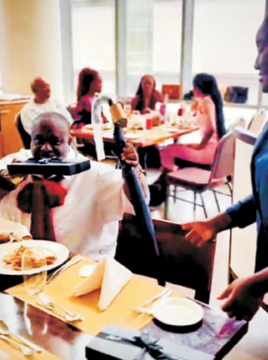

The book Feast for the Eyes explores chronologically the way food has been photographed since the 19th century with over 200 photographs.
Before the days of blogs and entire Instagram accounts dedicated to the wonderful world of food — documenting food was left to professional photographers, who, through careful decision making and curating captured the culinary delights for cookbooks, advertisments, and art.
Just as food consumption has changed over the years, so has the way societies plate, present, and document food.
In the new book, Feast for the Eyes: The Story of Food in Photography, author Susan Bright explores chronologically the way food has been photographed since the 19th century with over 200 photographs. Ahead, 15 stunning images from the book that show how drastically food photography has shifted since then.
In the book, Bright acknowledges the importance that food has on culture. "Food can signify a lifestyle or a nation, hope or despair, hunger or excess" she writes. Here, an elaborate still life of various native fruit taken in Sri Lanka in 1860 was sold as a souvenir to naval, military, bureaucratic, and merchant visitors.
This postcard, which is manipulated to depict over-sized eggs and potatoes in a car, play on the idea of American abundance. "Food is the perfect way to suggest wealth and plenty, and cards such as these did their part to promote the myth of a rural American utopia," writes Bright.
Color photographs began appearing in the early 1900s, and photographer Wladimir Schohin explored the complex process of autochrome, which used potato starch to help create the color.
Near the end of the Great Depression photographer Russell Lee was working for the FSA, documenting poverty in communities that didn't have an abundance of food, such as Pie Town, New Mexico.
As color photography became more popular, and a technically easier to create, photographers such as Nickolas Muray helped set the tone for 1940s food photography.
"...his food photographs are elaborate tableaux of staged props and food. They represent a land of plenty — a bountiful and idealized America, freed from the food restrictions and hardships of the New Deal," writes Bright.
Photographer Victor Keppler helped bring bold colors into food advertising, such as this photo which was used for a General Mills advertising campaign, promoting Apple Pyequick pie mix.
While working as a professor of electrical engineering at MIT, Harold Edgerton experimented with a stroboscope, a bright flash of light, that helped cameras capture moments that the human eye couldn't.
Photographer Stephen Shore is known for his photos of American culture. This photo, of his breakfast at Trail's End Restaurant in Kanab, Utah in 1973 has been celebrated by various photography critics.
Jo Ann Callis' more calculated approach, differs from Shores. " Her treatment of the food is obsessive and tense, relying on saturated, cinematic lighting to create an unknown drama seemingly set in the 1950s or 1960s," writes Bright.
British documentary photographer Martin Parr has documented every-day food, and its consumption for years. "Parr concentrates on what is considered "ordinary" food; this is not the stuff of banquets or weddings, but of church bake sales and butchers’ slabs," writes Bright.
In fine art, food can also represent overindulgence, such as in Tim Walker's "Self-Portrait with Eighty Cakes."
Today, some artists such as Laura Letinsky are looking back at seventeenth-century Renaissance paintings for inspiration when documenting food.
Others are creating completely new concoctions — such as Lorenzo Vitturi, who was inspired by the mix of cultures and foods found at his local market in the East End of London.
Bright also looks at the current food photography landscape and the independent food magazines, such as Gather and Gourmand, that are pushing the limits of food photography.
The book Feast for the Eyes explores chronologically the way food has been photographed since the 19th century with over 200 photographs. Read Full Story
















Facebook
Twitter
Pinterest
Instagram
Google+
YouTube
LinkedIn
RSS